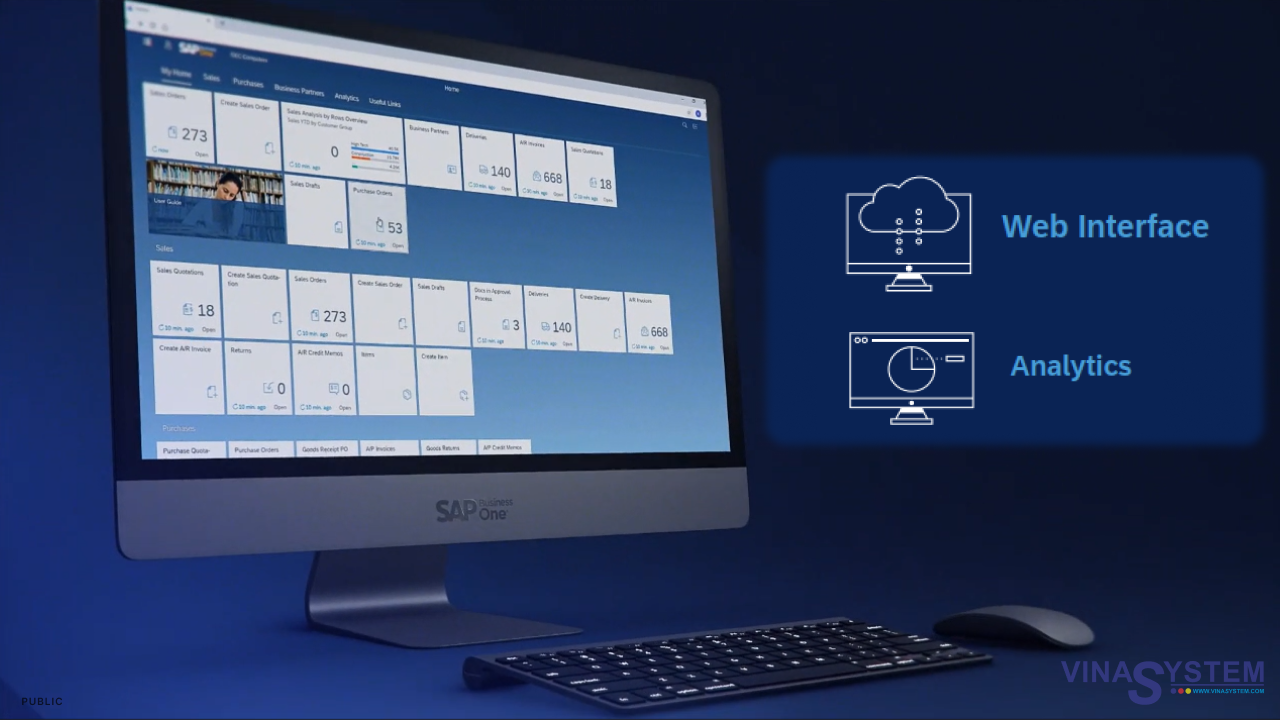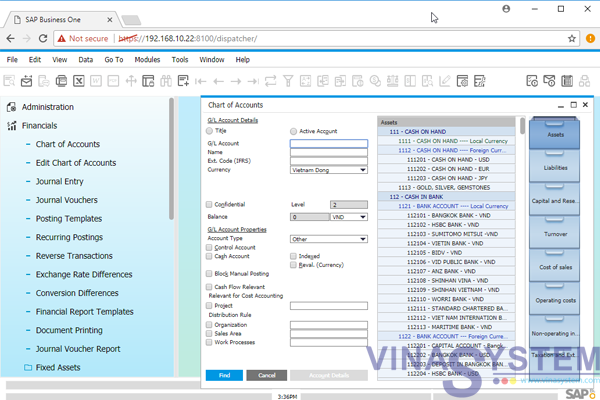
Tài liệu về quy trình lập kế hoạch nhu cầu NVL trong SAP Business One (MRP)
At the end of this topic, you will be able to:
- Explain the MRP concept and process steps
- Run the MRP wizard
- Use the MRP recommendations to automatically generate production or purchasing documents
We begin by introducing the concepts behind MRP in better to understand the process and its recommendations.
We discuss the definitions and planning data required to run the MRP wizard including the Forecast.
Then we explain the steps of the MRP wizard
Finally we examine the MRP results and see how to automatically generate production or purchasing documents from the recommendations.
I/ Business Scenario
OEC Computers sells office equipment and supplies.
Some of the items they sell are assembled and manufactured at OEC Computers’ labs.
The procurement manager, would like to be able to plan ahead for sales demand and item availability
II/ MRP Concepts
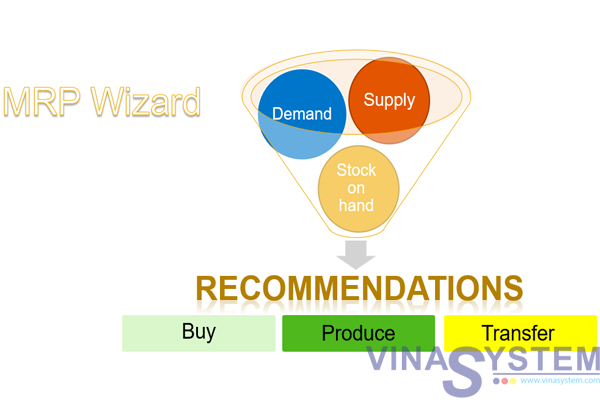
Materials Requirements Planning (MRP) is a tool for managing inventory effectively so that materials are available for production and products are available for sales when and where they are needed without having to keep overly high stock levels. MRP compares the future demand for items against the stock on hand and the planned supply from purchases, production, or items in other warehouses.
Planned supply can include purchase orders, production orders, inventory transfer requests and purchasing blanket agreements.
Existing demand comes from incoming sales and inventory needs and planned demand by forecasts.
In order to receive recommendations for buying, producing or transferring items you run the MRP wizard.
The MRP run also takes into account defined planning rules like order multiples and minimum order quantity and also required lead time for the supply or manufacturing of the item.
Note: throughout this course we refer to material as items or quantity in order to align with SAP Business One terminology.
MRP Example:

In the example shown, you can see an illustration of the recommendations given by MRP.
At the top, we see the situation before MRP is run.
- The initial stock quantity is represented in gold. Initially there were 20 pieces in stock.
- A purchase order exists for 30 pieces. We expect those receipts shortly in the future based on the lead times for the items.
- We have requirements for 40 pieces from existing sales orders.
- We have a sales forecast for 50 additional pieces in the near future and later on we expect demand for additional 30 pieces.
When we run MRP, we receive recommendations for three purchase orders to fulfill the requirements.
MRP considered the initial stock, planned supply and existing and forecasted demand.
III/ MRP Components
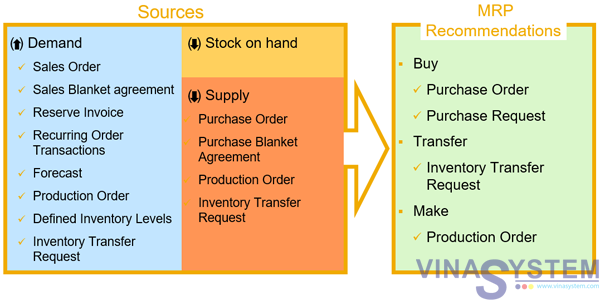
In order to understand the MRP logic better, let’s look in more detail at the 3 types of sources used in the MRP run: Demand, Stock on Hand and Supply.
Demand tells us how much item quantity will be needed in the future. Demand is derived from the following sources:
- Sales documents including sales orders, sales blanket agreements, reserve invoices and recurring order transactions,
- A forecast for the anticipated quantity needed for the item,
- Production orders for the child items of a BOM,
- Defined inventory levels including minimum, maximum and required inventory levels,
- And inventory transfer requests for the origin warehouse of planned transfers of the items.
To meet the demands, the wizard looks at the stock on hand (item quantities currently in the warehouse) and expected supply.
The expected supply of item quantity is derived from the following sources:
- Purchase orders and purchase blanket agreements
- Production order for the demand of the parent item of the BOM,
- And inventory transfer request for the target warehouse of planned transfers of the items.
The results from the MRP run are the MRP recommendations to buy, transfer or make the quantity needed.
The recommended documents can be:
- Purchase orders or purchase request for purchased items.
- Inventory transfer requests.
- And production orders for items that are produced in-house.
IV/ MRP Process Overview
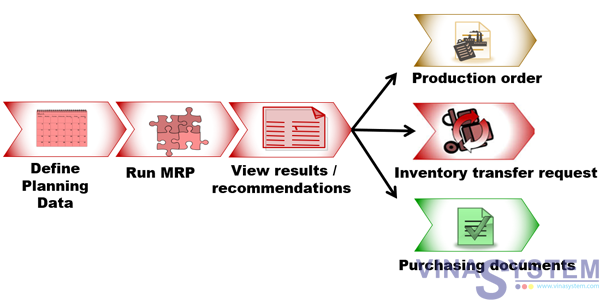
Before running MRP, you need to define planning data. The main planning data consists of definitions in the item master data records. In addition, there is also an option to define a forecast for anticipated demand of the items.
Once the planning data is set up, you can run the MRP wizard on demand.
The results of the MRP run are recommendations for creating documents to produce, purchase or transfer the needed items.
The final step in the MRP process is to use the recommendations to create the needed supply documents (such as production orders, inventory transfer requests or purchase orders) to meet the demand. These documents can be automatically generated via the Order Recommendation window.
In this next section, we will go through each MRP process step in detail. For each step you will see how MRP is integrated with the procurement and production processes.
IV/ Defining Planning Data
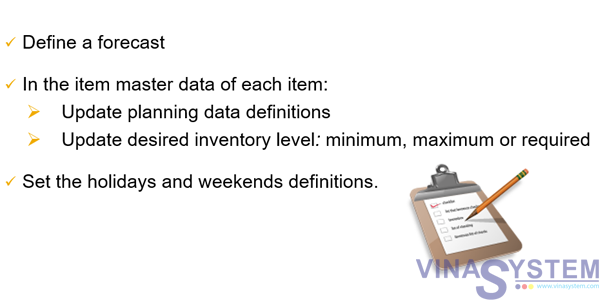
Here we see a list of suggested actions to perform before running the MRP wizard
None of these definitions are mandatory and you may decide that some are not relevant for you, but you should at least be familiar with them before running the MRP wizard for the first time.
No particular order of definition is required.
We will start by learning about the forecast functionality, and the way to define it.
Then we will go over the planning data and inventory level definitions in the item master data, relevant for the MRP run.
And finally, we will see how the holidays and weekend definitions can affect the MRP results.
1/ Defining Planning Data: Forecast
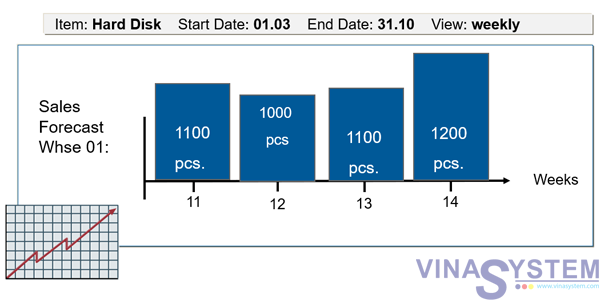
You can create forecasts to plan purchasing, production or transfers in advance, even before you receive other actual requirements like sales orders.
In OEC computers, sales orders are often received at short notice. Some of the items they sell have long lead times. If OEC Computers relied on only sales orders to drive their production and purchasing, they would not be able to meet demand because on the customers’ required dates.
That is why they use forecasts. By using a forecast, they can purchase or produce items based on predictions of when the items will be needed. When the actual sales orders arrive, they are able to supply the goods even at short notice.
In the image we see an illustration of a weekly forecast for the Hard Disk item in OEC Computers. To make sure there are sufficient hard disks on hand to meet expected orders, Michelle prepares a weekly forecast for the item. She bases her forecast on last years sales figures and adds a certain margin for the current year. Then, when she runs MRP, the recommended quantities already include the forecasted demand.
At OEC, they have found that some items sell better in different regions. To handle the differences, they create and maintain forecasts for items per warehouse.
To avoid duplication of sales order demand and forecast demand, you can define in the general settings that forecasts are consumed by actual sales orders.
You can learn about more about forecasts and how they are consumed in the topics MRP – Intelligent Forecast and MRP – Forecast Consumption.
2/ Create a Forecast
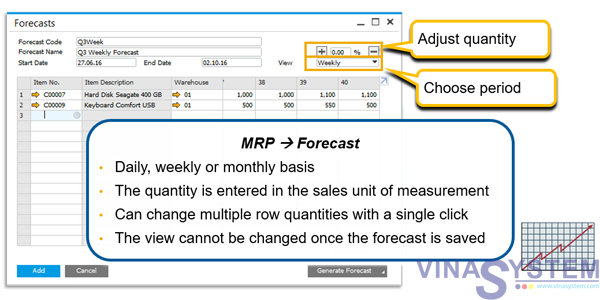
In our example, we will create a basic forecast.
There are two types of forecasts: basic and intelligent. The intelligent forecast function enables you to use various algorithms for forecasting product demands in an intuitive way.
In order to create a new basic forecast, go to the MRP main menu and then choose Forecast.
Each forecast row is defined per item. The quantity entered is based on the sales unit of measurement for the item. For example, if the item is sold in cartons of 12 then the forecast is based on the number of cartons. The item quantity can be managed on a daily, weekly or monthly basis. This view definition cannot be changed once the forecast is saved.
Enter the Start and End date to define the forecast period.
After entering required quantities, you can increase or decrease the quantities of selected items. Just choose the relevant item rows and then use the plus or minus button to increase or decrease the quantities by 5% with each click.
3/ Generate Forecast
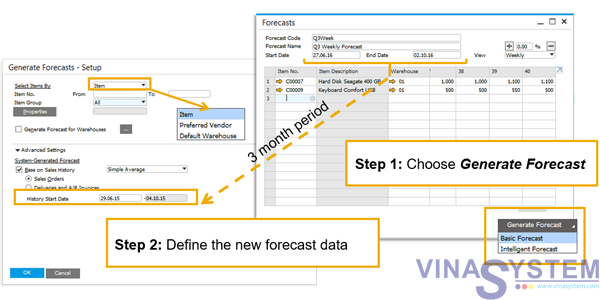
One way to simplify the process of creating a forecast is to use the option to automatically generate forecasts.
The first step is to choose the Generate Forecast button in the Forecasts window to open the Generate Forecast – Setup window. You have the option to choose a basic forecast or an intelligent forecast. These choices are discussed in more detail in later course topics. In this example, we will choose the basic forecast.
The second step is to define the criteria for adding items to the forecast. You can choose to add all items related to a certain default warehouse, a preferred vendor, an item group or specific properties.
You also have the option to use advanced settings to project forecast quantities based on historic sales information.
- The historical data can derive from either sales orders or deliveries and invoices.
- You can choose between a simple average and a periodic average:
- In the Simple Average option, the system sums up all quantities of the item in the historic period and then divides the entire quantity evenly for each period in the forecast.
- The periodic average can be daily, weekly or monthly, depending on the periodic view of the forecast. In the periodic average, no actual average calculation is made. The system just updates the quantity sold (or ordered) in the corresponded period of the historic period.
- The historical period is defined by entering a History Start Date. The system automatically enters an end date. This end date creates the same time range defined in the main Forecasts window.
Choose OK to generate the forecast.
V/ Item Master Data
1/ Planning and Procurement Methods
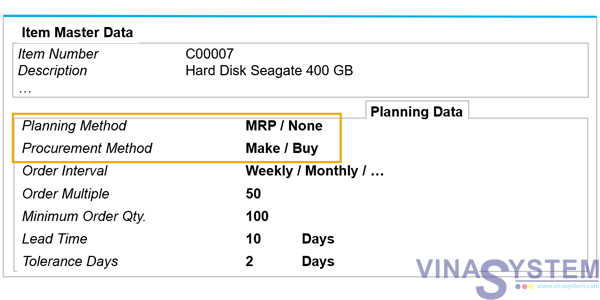
On the Planning Data tab of the Item Master Data window, you can set definitions relevant for the MRP run.
For each item you can define whether or not it is included in the MRP run by choosing MRP or None in the Planning Method field.
In the Procurement Method field you can define whether you purchase the item or produce it.
- This setting affects the default for the type of recommendation you receive from the MRP run.
- You can choose between the options Buy to receive recommendations for purchasing the item and Make to receive recommendations for Production Orders (taking demand and supply data for all BOM components into account).
- Note in both cases the recommendation can be to transfer the item from another warehouse. We will talk about the MRP recommendations later on in this training.
2/ Additional Planning Data
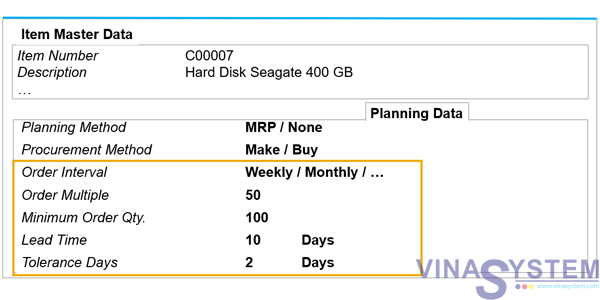
Besides the Planning Method and Procurement Method there is additional data that can be used for planning.
The Order Interval field specifies the frequency for order recommendations. You can define the intervals you need. You can define many intervals and choose the relevant interval for each item when needed. The Order Interval definition can be useful when an agreement exists with a vendor, for example, to order once a week – for example on Mondays only. MRP automatically groups recommended orders into interval groups for your convenience.
The Order Multiple specifies the lot size to use in an MRP run. For example, if the value is 50, MRP will recommend order the item in multiples of 50. So if you need 80 items and the value is 50, the system will recommend ordering 100 items.
The Minimum Order Quantity field allows you to specify a minimum lot size.
The Order Multiple and Minimum Order Quantity definitions can also be a representation of a supply agreement with the vendor.
The Lead Time field is used to calculate the duration of time to produce the item or receive the item when buying it.
The last field in the list is the Tolerance Days. An expected supply may arrive within a few days after the actual demand date and sometimes it would be ok to delay delivery. This functionality minimizes recommendations and satisfies demand with the expected supply due within the tolerance period. In the Tolerance Days field, indicate how many days you are willing to tolerate.
If you are using the advanced availability to promise functionality (ATP), you will also have the option to specify a checking rule. For more information on advanced ATP, see the course topic on automating the sales process.
In addition to entering the planning data directly in each item master data record, you can also define the planning data at the item group level. This definition is copied automatically to the item master data as a default.
VI/ Basic Scenario – Planning Data Influence
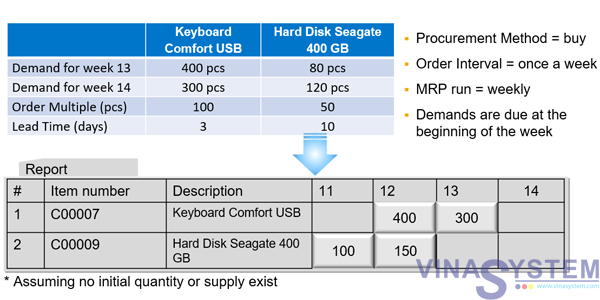
Let’s look at a basic scenario involving two items that OEC Computers resells:
Both items were defined as Buy items because they are not manufactured in-house by OEC Computers.
The first is a keyboard and the second is a hard disk.
Look at the upper table. You can see there are different demand quantities for the items for weeks 13 and 14.
The keyboard demand is 400 units for week 13, but since the order is due in the beginning of the week and the lead time of the Keyboard is 3 days, the recommendation appears in week 12.
The demand for the 300 units appear in week 13 for the same reason.
Now let us look at the hard disk item.
The demand for week 13 is 80 units but since the Order Multiple definition of the item is 50, the recommendation quantity is 100.
Note that the recommendation appears in week 11 since the lead time for this item is 10 days.
The demand for week 14 rounds up to 150 and appears two weeks before the due week.
We will continue to explore the planning data effect on the MRP results later on in this training, using the same items and planning data definitions.
VII/ Inventory Levels
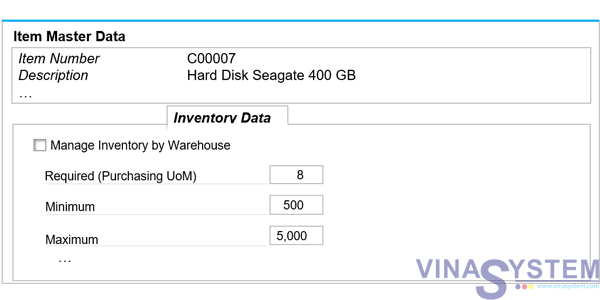
In the item master data we can define three types of desired inventory level of an item: Required, Minimum and Maximum levels.
- According to the values set in the minimum or maximum fields, the system can generate automatic warnings or restrictions when issuing sales or purchasing documents.
- When managing required quantity, the system can recommend to purchase the quantity needed to reach the required level of inventory.
- Note the required quantity is managed in purchasing units of measure and the minimum and maximum levels are managed in inventory units.
Just like sales orders and forecasts, predefined inventory levels can also generate a demand for quantity in the MRP run.
When running the wizard the user can choose whether or not to consider one of the defined inventory levels.
Note, the image displayed here reflects the definitions needed when managing inventory by the company level.
When the Manage Inventory by Warehouse box is checked, the definition of the quantities is done at the warehouse level.
VIII/ Managing Holidays and Weekends
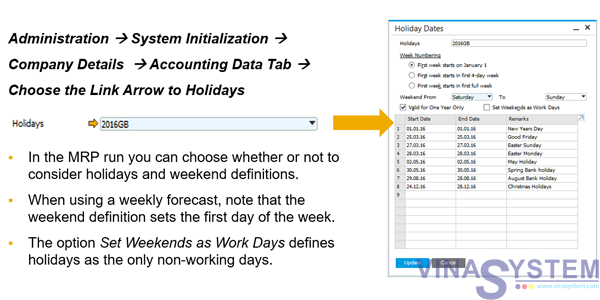
Finally, let’s look at how holidays affect the MRP results.
We already learned that the lead time defined in the item master affects the recommendation date. But what happens if the lead time occurs on holidays or weekends? Should we take this into account as well?
We can decide whether to consider holidays or not in each MRP run. But if we do intend to consider holidays and weekends in the lead time count we need to first update the holidays and weekend definition.
The weekend definition is also important if you work with weekly forecasts, since it defines the first day of the week. For example, in OEC Computers, the weekend is defined from Saturday to Sunday. This means the first day of the week that the weekly forecast is assigned to is Monday.
In addition you can also define only weekends and not holidays as working days in the MRP run. Just check the Set Weekends as Work Days box and in the MRP wizard choose to consider holidays.
IX/ Running the MRP Wizard
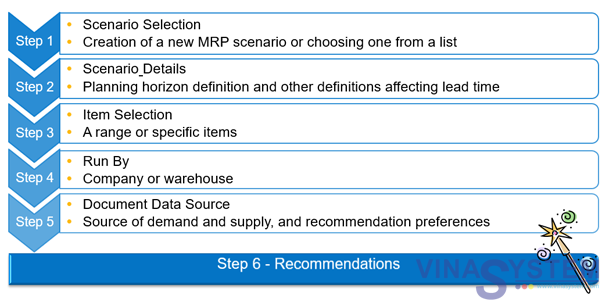
After you have entered the MRP definitions, you are ready to run the MRP wizard.
The wizard is a 6-step process and the final step presents recommendations derived from the parameters defined in the former steps.
In the next slides we will look into each step:
- In step 1 we will see how to select a scenario or create a new one.
- Then in step 2 we will define the planning horizon of the MRP recommendations and definitions affecting the purchasing or manufacturing lead time calculation.
- After that, in step 3 we will see how to choose the items participating in the MRP run.
- In step 4 We will look at the differences between running MRP at the company level and at the warehouse level.
- In step 5 we will see the different sources of demand and supply that can be included in the MRP calculation and go over some recommendation preferences.
Throughout this process we will use the basic scenario and build a wizard that will provide us recommendations.
1/ MRP Wizard - Step 1: Scenario Selection
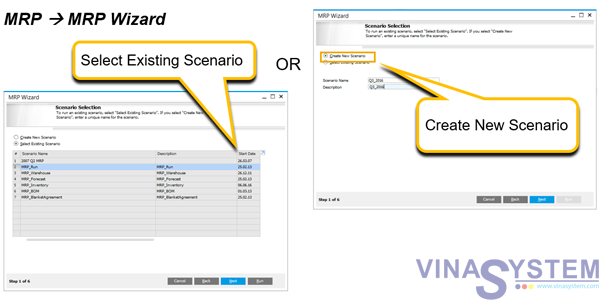
An MRP scenario is a set of parameters defined throughout the wizard steps. The scenario contains all the details for how to determine the results of the MRP run.
You can define several MRP scenarios for each company, but only one scenario can be used for each MRP run.
You can create a new scenario or choose a saved one from a former MRP run.
Let us create a scenario for the first quarter of the year.
2/ MRP Wizard - Step 2: Scenario Details
a) Planning Horizon
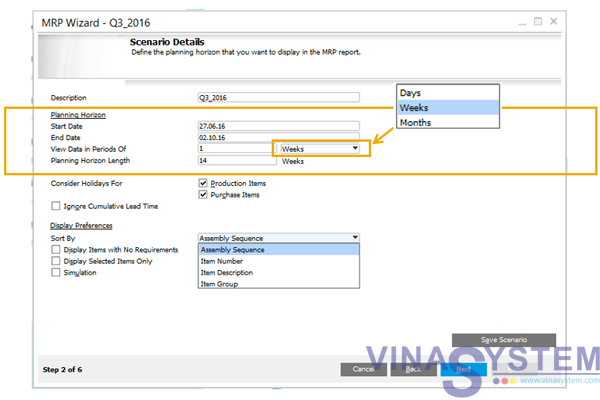
In step 2 of the wizard we enter the basic scenario details.
The main definition in this step is the horizon period definition. The MRP horizon is the period for which the wizard displays the MRP results. The start date cannot be later than today because if you used a later start date, you could overlook some recommendations that would occur between today and a future start date.
The MRP Report can be displayed in different period intervals: daily, weekly or monthly periods. You can also set intervals to be a number of days, weeks or months. Each interval is displayed in one column in the report. The interval is set by choosing a period (days, weeks or months) and setting the number of periods to be grouped in one result column. This view definition has no connection to the period intervals we chose in the forecast. For example, you can define a weekly forecast and a daily view of the MRP.
According to the period range and intervals entered, the system calculates the Planning Horizon Length value. This field displays the number of periods (or columns) that are going to be displayed in the MRP report. When changing this parameter, the End Date value is adjusted automatically to match the desired length.
Note, when entering the Start Date, the system may change and adjust the date entered to match the first day of the week or month of the start date. The system may also change the End Date to match the last day of the week or month.
b) Other Scenario Details
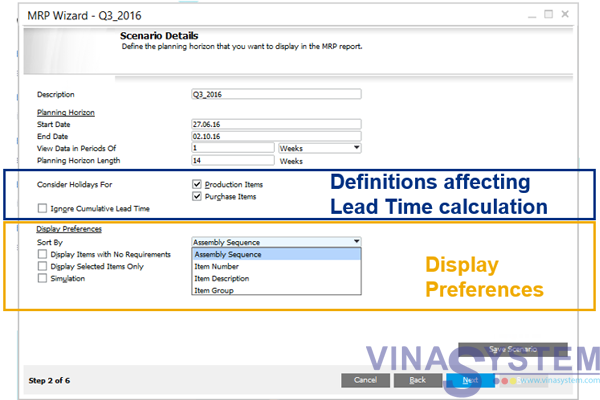
In step 2 of the Wizard we also define lead time and display definitions.
Look at the definitions affecting lead time calculation.
- You can decide whether to consider holidays or not. Michelle chooses to consider holidays for both production and purchase items since no production takes place at OEC during holidays and most deliveries from suppliers are also delayed due to local holidays.
- Another important definition is the Ignore Cumulative Lead Time check box. This definition is relevant for BOM items. If this checkbox is selected then the lead time will be taken from the lead time defined in the item master data. Otherwise, the lead time will be the sum of the lead times of all the recommended BOM components.
Look at the display preferences fields.
- You can sort the list of items displayed by item number, description or group. When working with BOM items, you can also sort the list of items according to the assembly sequence, from the highest BOM level to the lowest.
- To view all items in the MRP report check the Display Items with No Requirements box. Items with no requirements have sufficient quantity to meet demand and therefore, by default, do not appear in the MRP report. You can choose this option when examining the scenario results.
- SAP Business One also provides a simulation run. If the Simulation box is checked, the MRP scenario recommendations cannot be saved. Since saved recommendations are later used to generate documents, when running the wizard for test purposes, check the Simulation box.
3/ MRP Wizard - Step 3: Item selection
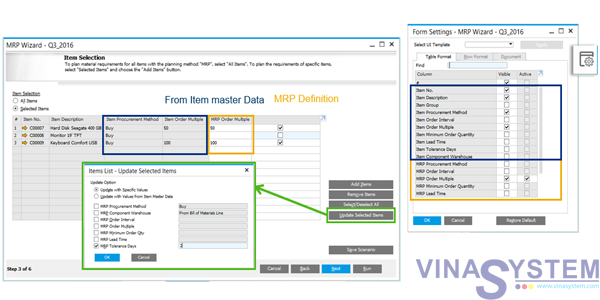
In step 3 choose the items to consider in the MRP run.
Choosing the All Items option uploads all items that have the Planning Method in the master data set to MRP.
Instead, Michelle chooses only the hard disk and keyboard items.
You can add two types of columns to the MRP Item Selection window: item data (illustrated in blue) and MRP data (illustrated in orange). This allows you to see the default values from the item master as well as values set for this MRP run. In our example, the Item Order Multiples value is set to 50 units in the item master data. If Michelle decides for the purpose of this MRP scenario only, that the order multiples will be only 20 units, then she can make the change in the MRP Order Multiple column. In the MRP run, the system considers the MRP fields and not the default item fields.
You can also update any of the MRP planning data for a batch of items all at once. Just select the check box of the items to be updated and choose the Update Selected Items button. There you can update MRP definitions for all the selected items. For example give all items selected an MRP Tolerance Days value of 2 days to consider late supply of these items.
Using the Add Items button, you can also choose items using criteria from fields such as preferred vendor or by user-defined fields in the item master.
4/ MRP Wizard - Step 4: Inventory Data Source

In step 4 of the wizard, you can decide whether to run the wizard by the company level or the warehouse level and choose which warehouses participate in the MRP run.
- The first option is to consolidate inventory quantities, demand and supply by the company level. This means all requirements and recommendations are calculated for the default warehouse. This also means no inventory transfer request recommendations will be given.
- The second option is to consider each warehouse separately. With this option, each warehouse has its own existing inventory and its own demand and supply. This also means that if there is a demand for quantity that exists in another warehouse, the system can recommend an inventory transfer request from the warehouse holding the desired quantity to the warehouse with the demand.
Michelle chooses to run MRP at the warehouse level.
Look at the Include Data Source table. The definitions made here are relevant for both Company and Warehouse preference.
You can decide for each warehouse if its initial quantities and sources of supply or demand are considered. For example if you have a sales order containing multiple rows from different warehouse, only the rows involving warehouses that are marked with Include Demand, will be considered as demand in the MRP calculation.
The warehouse list is ordered by location. In the image we see an expanded view of all the warehouses that exist in the company.
Note, even when running the MRP by Company, if a warehouse is not included as demand and the inventory level of the item is managed by warehouse, then the MRP calculation will not consider the non-included warehouses.
5/ MRP Wizard - Step 5: Documents Data Source
a) Sources
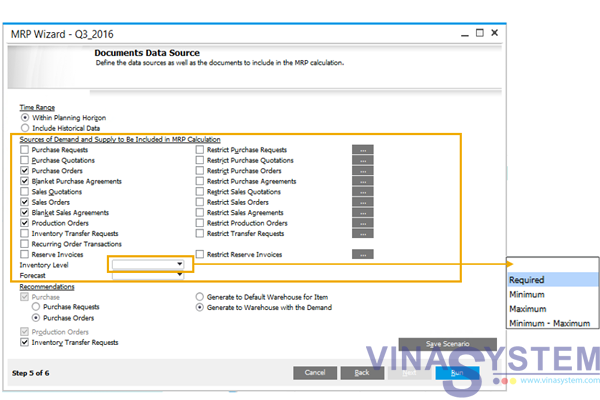
In step 5 you decide on the type of sources to consider in the MRP run and the type of recommendations to be given by the MRP Wizard.
Check the box of the sources you wish to include. You can also restrict specific documents. For example if you want to exclude a certain sales order because you think it may be canceled, in addition to checking the Sales Orders box, you should also check the Restrict Sales Orders box and choose the sales orders to include.
In addition to document sources, there are two more types of demand sources:
- The first is the Inventory Level. Here you choose the level of inventory you wish to fulfill. In the Inventory Level drop down list you can find the same inventory levels that can be managed for the item in the Inventory tab of the Item Master Data. In OEC Computers many items are managed by a predefined Required level.
- The second field is the Forecast. Here we can choose pre-defined forecasts to consider as additional demand in the MRP run. We will not use a forecast in the basic scenario.
b) Recommendations
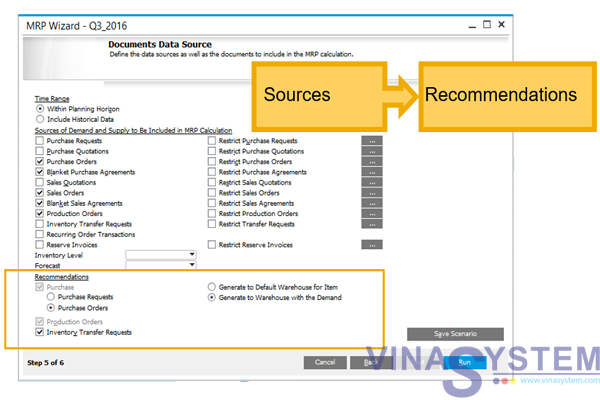
In step 5 of the MRP Wizard we can also choose types of recommendations:
- Depending on the company policy of procurement, you can choose between a Purchase Request and a Purchase Order. In OEC computers the procurement process starts with a purchase order. Other companies may have an approval procedure starting with a purchase request.
- If you chose to run the wizard at the warehouse level, then you have additional options in the Recommendations section of the window. You can decide whether to receive recommendations for Inventory Transfer Requests instead of Purchase Orders whenever available quantity exists in another warehouse. You can also choose whether to generate recommendations to the default warehouse or to the warehouse creating the demand
c) Time Range
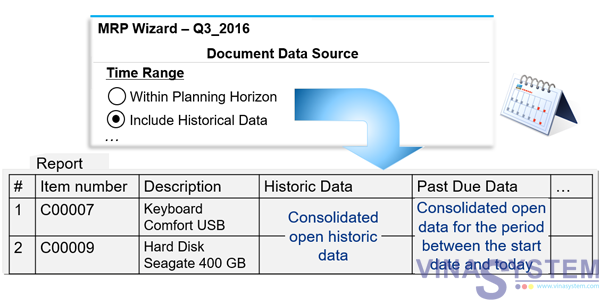
Another important definition in step 5 of the wizard is the Time Range definition.
When running the MRP, you can decide whether to include historical data, prior to the MRP start date, in the MRP calculation.
If we choose the option Within Planning Horizon then MRP calculations does not consider data prior to the wizard start date. If the start date is earlier than today, consolidated data between the start date and today will appear in the Past Due Data column. The first period column will display data starting from today.
If you do choose to include historical data, all documents before the start date are considered in MRP calculations. All data and recommendations are summed together into the Historic Data column. Note that the Historic Data column appears only when choosing to include the historical data option.
X/ MRP Reports
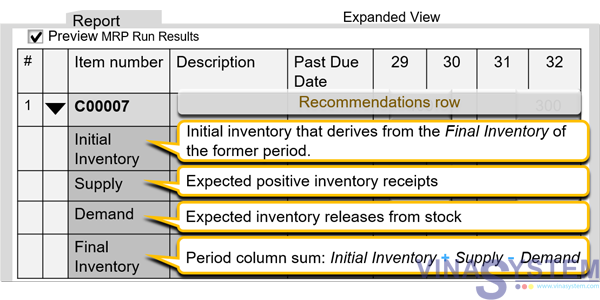
Choose the Run button to view the results.
The MRP Report displays in a collapsed mode - one line for each item. In this line you can find the MRP recommendations.
In the report we see columns for the Item Number and Description, another column for the Past Due Data and one column for each period according to the definitions we made in step 2 of the wizard.
Remember that in step 2 of the wizard, we chose a 1 week interval for the planning horizon of the 1st quarter of the year. The system has also automatically broaden the range of the period to begin on a Monday and end on Sunday. Since today is already week 11 we see only 4 columns representing the 4 weeks left until the end of the horizon period.
In the expanded view we see 4 fixed rows for each item that appear in the report:
- The first is the Initial Inventory. The Initial Inventory derives from the Final Inventory of the former period. The initial inventory of the first column represents the current quantity of the item in the company, according to the warehouses included in the wizard.
- The Supply quantity is the expected positive inventory receipts from the following selected documents for each period: Purchase Order, Production Order (for the parent item), Purchase Blanket Agreement (according to the planned frequency) and Inventory Transfer Request (for the receiving warehouse). Note the Supply row also includes the MRP recommendations for each period.
- The Demand quantity is the expected inventory releases from the following selected documents for each period: Sales Order, Sales Blanket Agreement (according to the planned frequency) , Reserve Invoice, Recurring Order Transactions (according to their planned due date), non consumed Forecast, Production Order (for the lower level items), defined inventory levels and Inventory Transfer Request (for the source warehouse).
- The last row is the Final Inventory which sums the Initial Inventory plus the Supply quantity minus the Demand quantity.
1/ MRP Report Timeline
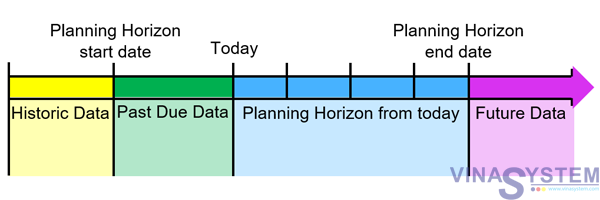
This diagram shows the timeline of the MRP report grid from the Historic Data to the Future Data. Using this diagram we will also summarize what we have learned so far about the different MRP report periods and also talk about the Future Data column.
We already learned that the Historic Data column only appears in the MRP report if we choose the option Include Historical Data in the Time Range definition in step 5 of the wizard. This column holds all historic data up to the start date of the planning horizon, consolidated together.
If the start date of the planning horizon is earlier than today then all the data that relates to the period between the start date and today is consolidated in the Past Due Data column. If the start date is today then no data will be presented in this column.
We also saw that the data related to the period between today and the planning horizon end date is split up and presented in multiple columns according to the View Data in Periods Of definition made in step 2 of the wizard.
The Future Data column displays consolidated data related to the lead time period which follows the planning horizon end date. In our case, since the lead time of the hard disk item is set to 10 days, the Future Data column will display all demand with due dates set within the next 10 days following the MRP wizard end date. Respectively, in the Future Data column, we will see recommendations (in the supply and recommendation rows) that satisfy this demand.
2/ MRP Report Color Legend
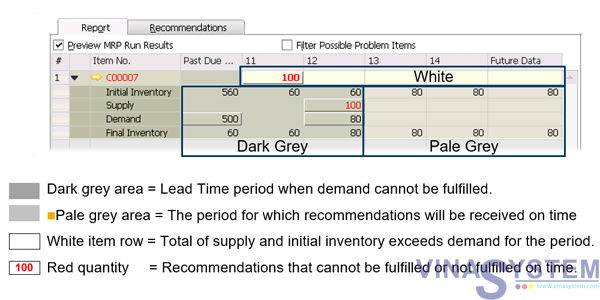
SAP Business One uses different colors to visualize the MRP results.
The lead time for an item is displayed in dark grey cells and means that the recommended order is unable to meet demands of orders with due date within the lead time. The lead time is calculated from today. In our example the lead time is 10 days and today March 10th (Monday of week 11). This means the lead time ends on March 20th, in week 12. Therefore weeks 11 and 12 are colored in dark grey.
The Past Due Data column always appears in dark grey since it represents demand with due date earlier than today. Using the same logic, and assuming the lead time of the item is greater than zero, then the first period column will be in dark grey as well, in our example it is week 11.
The rest of the period columns are displayed in pale grey.
The only row colored in white is the item row. Item row cells are displayed in white if the total of the supply and initial quantity exceeds the demand.
Recommendations that cannot be fulfilled or not fulfilled on time (commonly due to the lead time defined), appear in red and so is the supply of that recommendation.
Note that in some cases negative quantities may appear in the initial and final inventory rows. This negative quantity also appears in red.
Negative quantity appears when a demand is not fulfilled or not fulfilled on time. One reason can be a delay of supply due to tolerance days definition.
Another reason can be when we choose to view the report without previewing the MRP results. Let us examine this option in the next slide.
3/ Analysis of the MRP Report
a) Preview MRP Without Recommendations
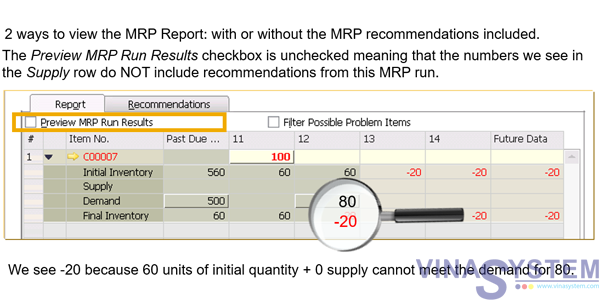
There are two ways to view the MRP Report: with the MRP recommendations included and without recommendations. The Preview MRP Run Results checkbox is unchecked in this example, meaning that the numbers we see in the Supply row do not include recommendations from this MRP run.
Look at the Past Due Data column. We started with initial quantity of 560 units and in the demand cell we see a total of 500 units.
Let us look at week 11 column. We already learned that the final inventory value becomes the initial inventory of the following period. Therefore, the initial inventory of Week 11 is 60 units which was the final inventory of the Past Due Data column.
When we look at the final inventory of week 12, we see a total of -20 units that appears in red. This is the result of the following calculation:
- 60 units initial quantity
- (+) 0 units of supply
- (- ) 80 units of demand
In the next slide we will see what happens when we do choose the Preview MRP Run Results check box.
b) Preview MRP Run with recommendations
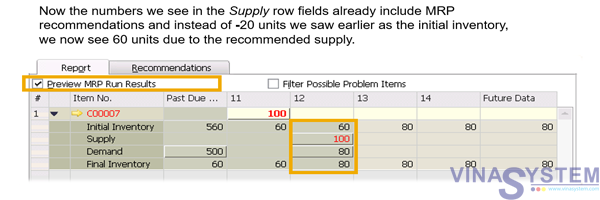
This time we choose to preview the MRP run results.
Now the numbers we see in the Supply row fields already include MRP recommendations and instead of -20 units we saw earlier as the initial inventory, we now see 80 units due to the recommended supply.
Look at the Supply row. Supply quantity was added to week 12. This means it is a recommended supply.
The red color of the supply quantity of week 12 indicates we cannot meet the desired due date because of the item lead time definition.
In the next slide we will try to understand where these numbers come from.
c) Pegging Information
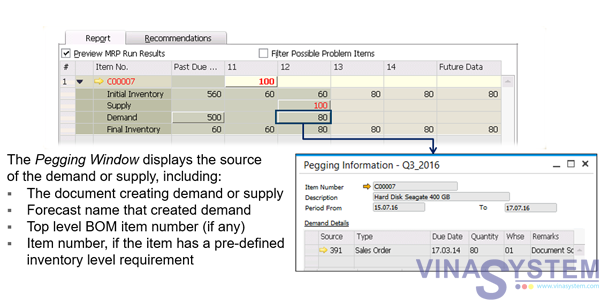
When we look at the MRP report we see many raised cells.
When we click on any of these cells the Pegging Information window opens. The pegging information lists the sources or recommendations that add up to the quantity that appears in the cell. This is a tool that helps us understand and analyze the quantities displayed in the cell.
The Pegging Information window exists for recommendations, supply and demand data.
In each window we can see the following information:
- The source of the demand and supply. The source can be:
- The number of the document that created the demand or supply,
- The name of the forecast that created the demand,
- If the item is a BOM then the top level item number of the lower level item requirement appears
- And if the item has a pre-defined inventory level requirement then the item number appears.
- Note that an empty source column in a supply pegging information means this is an MRP recommendation.
- In the image we see the sales order numbers in the source column.
- In the Pegging Information window we can also find:
- The Type column that contains the name of the source document type,
- The Due Date, Quantity and Warehouse of the source
- And a Remarks field. In this column we can find automatic remarks that indicates, according to the type of the pegging information if it is a recommendation, supply from recommendation, a regular supply source or a demand.
XI/ Filter Possible Problem Items
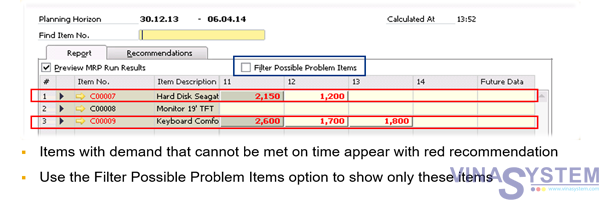
Items with demand that cannot be met on time appear in red.
Use the Filter Possible Problem Items option to filter the report and show only these items.
After Michelle reviews the MRP report she selects the Filter Possible Problem Items checkbox to view items that do not meet demand. Then she takes one or more of the following steps:
- Notify the sales department of late arrivals,
- Contact the vendor and try to hurry up the expected shipment of the ordered items
- Or examine other possible vendors that can supply the goods faster
XII/ MRP Results - Recommendation Tab
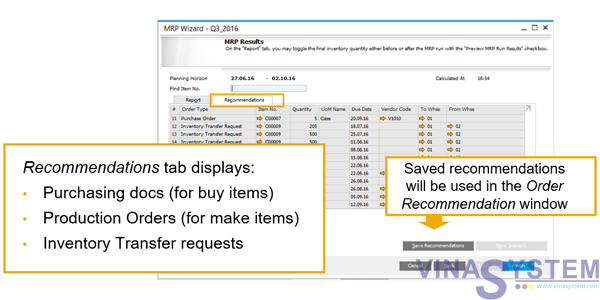
Now that we finished analyzing the MRP report, let us talk about the Recommendation tab. Here we see a list of all recommendations: purchasing documents (order or request), Production Order and Inventory transfer Request in one easy to use report.
This is the same data we saw in the Pegging Information window for recommendations including due dates marked in red for recommendations that will not meet the demand due date.
In the image displayed here we see recommendations for the Hard Disk item (item code C00007).
Since the item is defined as a Buy item, we do not see a recommendation for any production order. However we do see a recommendation for an inventory transfer request as we saw before in the Report tab.
Look at the Vendor Code column. The system recommends a vendor for the purchase order. This vendor is the default preferred vendor defined in the item master .
Note that all data is grayed out and is not editable. In the next slide we will get to know the Order Recommendation window where data can be adjusted and recommended documents can be produced.
Choose the Save Recommendations button to save the recommendations. They will be used later on to generate documents in the Order Recommendations window. When choosing the Finish button the system will also suggest to save recommendations.
XIII/ Order Recommendation Window
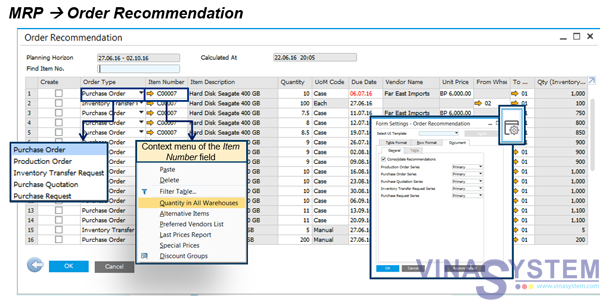
The Order Recommendation is a separate window that allows you to update and change fields displayed in the Recommendation tab of MRP Results as well as generate supply documents.
The data displayed in this window comes from the last saved MRP run recommendations for the selected scenario.
In the Order Type field, choose the desired document to generate based on the recommendation, and check the create box. Note you can also choose to generate a Purchase Quotation document.
Choose the Update button to generate the document.
Note that you must enter data in all the active fields to generate the document.
From the context menu of the Item Number field you can generate different reports already filtered for the item, like Alternative Items and Last Prices report. These reports can help you adjust the row data before creating the documents.
The numbering of the documents are set according to the series chosen in the Form Settings window.
Here you can also choose whether or not to consolidate documents to the same vendors. When doing so, we can benefit twice:
- First, we minimize the number of generated documents and thus reduce logistics and maintenance costs.
- Second, we may also achieve greater quantity related discounts
XIV/ Summary
Here are some key points to take away from this course:
- The Material Requirements Planning (MRP) is a planning tool that calculates material requirements for produced or purchased items by processing the demand, supply and item quantity. To receive recommendations for buying, producing or transferring items we run the MRP wizard.
- The demand for items is derived from sales documents, a forecast, production orders, defined inventory levels and inventory transfer requests.
- The wizard also considers expected supply from purchase orders, production orders and purchase blanket agreements.
- The results of the MRP run are the MRP recommendations. The recommended documents can be: purchase orders, purchase request, inventory transfer requests and production orders.
- Forecasts are used to plan stock level in advance, before receiving actual requirements, such as sales orders.
- In the planning data of the item master, you can set parameters, such as order multiples and lead time, that affect MRP recommendations.
- An MRP scenario is a set of parameters defined throughout the wizard steps that is used to determine the MRP results.
- The horizon is the period for which the wizard displays the MRP results.
- The MRP results also display past due data and future data. You can also choose to display historic data prior to the MRP horizon.
- There are four elements in the MRP Result: Initial Inventory, Supply, Demand and Final Inventory
- SAP Business One uses different colors to visualize the MRP results.
- In the Recommendation tab of the MRP results we see the list of all recommended documents.
- From the Order Recommendation window we can generate recommended documents.



